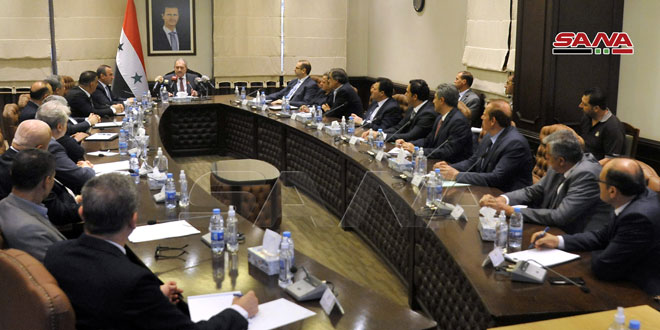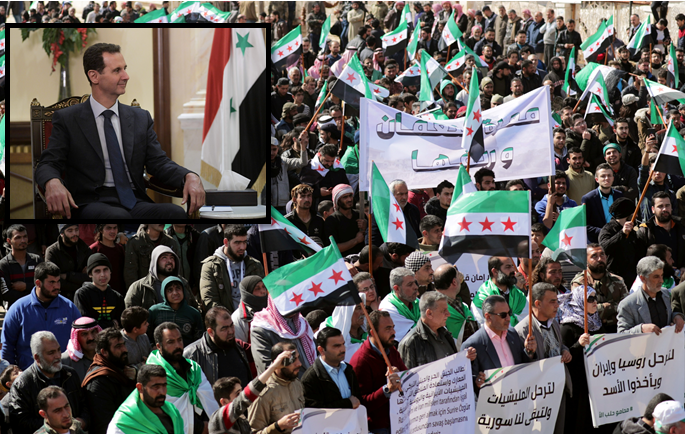Publications
INSS Insight No. 1340, June 29, 2020
On the twentieth anniversary of his rise to power, Bashar al-Assad faces governance and sovereignty challenges posed by the still-unfinished civil war, including the destruction and devastation of infrastructure, the foreign presence in Syria, and the lack of control in the Idlib region – the last significant rebel enclave in the northwest of the country – as well as in the east. At the same time, an economic crisis is worsening, new American sanctions have been imposed, public protests are held, and there are rifts among Assad’s close circle. The confluence of developments may create a window of opportunity, however narrow and temporary, for a renewed diplomatic effort led by the United States, Russia, and Turkey to try to bring Syria back onto a stable political and civilian path, perhaps even under new leadership.
"Someone who starves his people is a traitor"; "I can't breathe…the revolution continues"; "Liars, the Syrian press are liars"; "We want to live"; "The people want to topple the regime"; "Syria, free Syria, Iran and Russia out"; "Syria belongs to us, not to the Assad family"; "From Idlib to Suwayda – we are with you." These are just some of the slogans heard recently in Syria, particularly in the southern city of Suwayda, where there is a rising wave of protest against the regime and against the "Assad system." Now that major hostilities in the Syrian civil war have ended, public expectations and demands are rising. Unlike the generic cries of protest heard regularly throughout the region, these chants in Syria are accurate reflections of the country’s plight, and they indicate the grim, unstable situation of President Bashar al-Assad as he faces these challenges.
The economic crisis
Demonstrations in Suwayda, the stronghold of the Druze, who supported Assad during the course of the war, began by calling for an improvement in the economic situation and living conditions. These protests subsequently became demonstrations against the regime and Iranian civilian involvement in the region. The background for this protest is the collapse of the Syrian pound, which was traded at 47 to one US dollar before the civil war, and now trades at 3,500 to one US dollar. This has caused dramatic price increases and forced shops to shut down; food prices have risen by more than 50 percent. The economic crisis that Syria was already experiencing as a result of the war was worsened by the closure imposed to prevent the spread of the coronavirus; by Western sanctions imposed on the country; by the rapid devaluation of the currency; and by the deep economic crisis in Lebanon. An estimated 80 percent of the Syrian population today live below the poverty line.
In addition, the United States has begun to implement the Caesar Act in Syria – a move referred to by Syrian and Russian governments as “economic terror” – whereby 39 sanctions will be imposed on persons connected to the Syrian and Iranian regimes, as well as on family members of President Assad. However, the US administration declared that it would backtrack on this plan (which includes three stages to be implemented by the end of August) if Syria returns to negotiations in the framework of UN Security Council Resolution 2254 of December 2015, which drafts a road map for a peace process in Syria.
As part of the attempt to handle the economic crisis, on June 11, 2020 Assad fired Prime Minister Imad Khamis and replaced him with then-Minister for Water Resources Hussein Arnous. The move showed how badly Assad feels threatened by public protests and the economic crisis; it was intended to convey that Khamis was more responsible for this situation than Assad. Assad's central concern is about cracks in his support circles that survived the damages of war without wavering, but now have been harmed by the economic crisis. Initial indications of such discontent can be seen in the discourse among presidential supporters on the social media.

The coronavirus crisis as a crisis of trust
The coronavirus pandemic did not bypass Syria, but thus far the extent of the outbreak is limited, and according to official sources there are fewer than 200 infected persons in the country. Although it is difficult to correctly estimate the actual number of persons infected, and in spite of assessments that the closure’s economic damage is limited because the country's shaky economy was already isolated from world markets, the coronavirus outbreak has most of all deepened the crisis of public trust in the leadership. The policy of deliberate obfuscation by the regime and its affiliated media, as well as the selective measures to combat the virus, including the allowance of flights from Iran the unobstructed entry of Shiite militias into the country even at the height of the outbreak, proved once again to the Syrian public that Assad's personal, political, and military interests outweigh considerations of the country's well-being. A rapid outbreak of the coronavirus in Syria is likely to be an additional expediting factor leading to widespread public unrest.
Rifts in Assad's inner circle
A conflict erupted recently between President Assad and his cousin Rami Makhlouf, who is considered the wealthiest man in Syria. Makhlouf owns Syriatel, the largest telecom firm in the country, and is one of its largest importers of oil and consumer goods. After supporting the Assad regime militarily and economically throughout the war, Makhlouf was fined $3 billion; after he refused to pay, the regime began arresting his workers and impounding his assets. In an unusual move, Makhlouf exposed the internal family conflict in a series of videos uploaded to social media. In one of the videos he mocks the arrest of his workers by members of the security and intelligence forces – entities that he supported and funded for years. The conflict reflects the tension between Assad and his inner circle, which, unsurprisingly, makes up the economic elite of Syria, and reflects the economic pressure on the President.
Foreign involvement challenges sovereignty
Protest chants express resentment and disgust at the foreign presence on Syrian soil. Reports from recent months indicate that Russia is deepening its hold on the country by establishing new military bases, controlling swathes of land, and widening its access to the Mediterranean Sea. The recruitment of Syrian fighters to fight alongside Russian-supported Khalifa Haftar in Libya demonstrates Russia's intent to make Syria a center for its activity and a base for its regional struggles.
At the same time, criticism of Assad is sounded in official Russian media; he is described as weak, corrupt, and lacking in public support. Russia's motives in this matter are not clear; perhaps Russia has had enough of the Assad regime and is preparing to remove him, but perhaps it is only applying pressure on him so that he will allow Russia to take further control of Syria's economic resources. In any event, this criticism and its timing do not ease the situation for Assad.
An additional dispute is underway over the Iranian presence in Syria. Recent statements in the United States and Israel imply that Iran is reducing its presence in Syria due to increased Israeli attacks on Iranian targets in the country and due to the severe economic pressure on Iran. Whether or not Iran is limiting its forces, it is clearly changing the structure of its deployment in Syria and seeking to disguise its activity, by embedding its operatives in Syrian military bodies, providing economic and civilian cover to military activity, and recruiting local fighters. Reducing Iran's profile in Syria serves the Assad regime by lowering his image as an Iranian puppet, and perhaps by moderating Israeli attacks on Syria as well; it also serves Moscow, which is then perceived internationally as having restrained Iranian activity. In practice Iran and Russia, which saved Assad from collapse during the war, not only limit his ability to consolidate control over all of Syria, but also lack the practical ability to save him from Syria’s economic crisis.
Turkey also presents an obstacle to Assad’s efforts to complete his conquest over the country. It has de facto rule over areas of northern Syria and prevents Assad from launching a major military offensive to conquer Idlib. It also introduced the Turkish lira as the currency in the territory it controls, in order to protect local residents from the rapid fall of the Syrian pound. Ankara has thus further damaged the image of Assad as a functioning president.
Time for Syria without Assad?
Assad's weakness and vulnerability present the international community, led by the United States, with a window of opportunity. Assad committed war crimes and caused humanitarian catastrophe and widespread devastation. Thus far, the international community has accepted his continued rule, but in light of the confluence of recent events, which reflect a significant weakening of domestic support for Assad, a renewed assessment of this policy is in order.
Israel is engaged in a military campaign against Iranian entrenchment in Syria, while the United States is furthering its economic struggle against the regime. The missing link in this equation is a forceful US-led diplomatic process, as an alternative to the weak diplomatic channels that have thus far failed to end the war and bring Syria back on track for political reform and civilian and economic reconstruction. Such a move requires tighter cooperation between the United States and Russia, which is also interested in ending the war and stabilizing the country, while taking advantage of their shared interests vis-à-vis Turkey. The objectives of this move would include the consolidation of a more representative and equality-based regime, a supervised and fair election process, constitutional reforms, a comprehensive reconstruction plan driven by regional and international support, and more. Under the current circumstances, it seems that almost any alternative form of governance in Syria would be preferable to the current situation, and the sooner the better.



